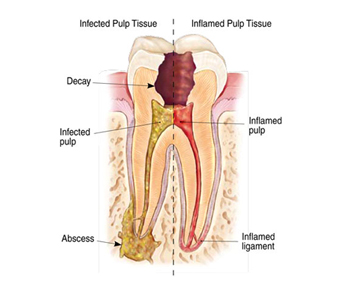Root Canal Therapy
 Endodontics is the branch of dentistry that deals with diseases of the tooth’s pulp, which is located in the center of the tooth and in canals (called root canals) within each tooth root. Pulp, consisting of connective tissue, nerves and blood vessels, nourishes the tooth when it first erupts (emerges through the gum). Once the tooth matures, the pulp can be removed safely from the pulp chamber and root canals and the tooth can be maintained. This is because the tooth also is nourished by a blood supply that surrounds the tooth. Removing the pulp is called endodontic treatment, but it is often referred to as root canal treatment or root canal therapy.
Endodontics is the branch of dentistry that deals with diseases of the tooth’s pulp, which is located in the center of the tooth and in canals (called root canals) within each tooth root. Pulp, consisting of connective tissue, nerves and blood vessels, nourishes the tooth when it first erupts (emerges through the gum). Once the tooth matures, the pulp can be removed safely from the pulp chamber and root canals and the tooth can be maintained. This is because the tooth also is nourished by a blood supply that surrounds the tooth. Removing the pulp is called endodontic treatment, but it is often referred to as root canal treatment or root canal therapy.
Why Would You Need Root Canal Treatment?
Root canal treatment is needed for two main reasons: infection or irreversible damage to the pulp. An untreated cavity is a common cause of pulp infection. The decay erodes the enamel and dentin of the tooth until it opens into the root canal system, allowing bacteria to infect the pulp. Infections inside teeth don’t respond to antibiotic treatment. The inflammation caused by the infection restricts the tooth’s blood supply, so antibiotics in the bloodstream can’t reach the infection very well. The reduced blood supply also limits the pulp’s ability to heal itself.
The pulp also can become damaged from trauma, a fracture or extensive restorative work, such as several fillings placed over a period of time. Sometimes, a common dental procedure can cause the pulp to become inflamed. For example, preparing a tooth for a crown sometimes leads to the need for root canal treatment.
In many cases, when the pulp is inflamed, but not infected, it will heal and return to normal.
Once the pulp becomes infected, the infection can affect the bone around the tooth, causing an abscess to form. The goal of root canal treatment is to save the tooth by removing the infected or damaged pulp, treating any infection, and filling the empty canals with an inert material. If root canal treatment is not done, the tooth may have to be extracted.
It is better to keep your natural teeth if at all possible. If a tooth is missing, neighboring teeth can drift out of line and can be overstressed. Keeping your natural teeth also helps you to avoid more expensive and extensive treatments, such as implants or bridges. If an infected or injured tooth that needs root canal treatment is ignored, not only can you lose the tooth, but also the infection can spread to other parts of your body.
Signs and Symptoms
If you have an infection of the pulp, you may not feel any pain at first. But if left untreated, the infection will cause pain and swelling. In some cases, an abscess will form. Eventually, the tooth may need to be extracted. Some indications that a tooth may need a root canal are:
A tooth that hurts significantly when you bite down on it, touch it or push on it
- Sensitivity to heat
- Sensitivity to cold that lasts longer than a couple of seconds
- Swelling near the affected tooth
- A discolored tooth, with or without pain
- A broken tooth
What does root canal therapy involve?
- A root canal procedure requires one or more appointments and can be performed by a dentist or endodontist (a root canal specialist).
- While the tooth is numb, a rubber dam (a sheet of rubber) will be placed around the tooth to keep it dry and free of saliva. An access opening is made on top of the tooth and a series of root canal files are placed into the opening, one at a time, removing the pulp, nerve tissue, and bacteria. If tooth decay is present, it will also be removed with special dental instruments.
- Once the tooth is thoroughly cleaned, it will be sealed with either a permanent filling or, if additional appointments are needed, a temporary filling will be placed.
- At the next appointment, usually a week later, the roots and the inside cavity of the tooth will be filled and sealed with special dental materials. A filling will be placed to cover the opening on top of the tooth. In addition, all teeth that have root canal treatment should have a crown (cap) placed. This will protect the tooth and prevent it from breaking, and restore it to its full function.
- After treatment, your tooth may still be sensitive, but this will subside as the inflammation diminishes and the tooth has healed.
- You will be given care instructions after each appointment. Good oral hygiene practices and regular dental visits will aid in the life of your root canal treatment.


